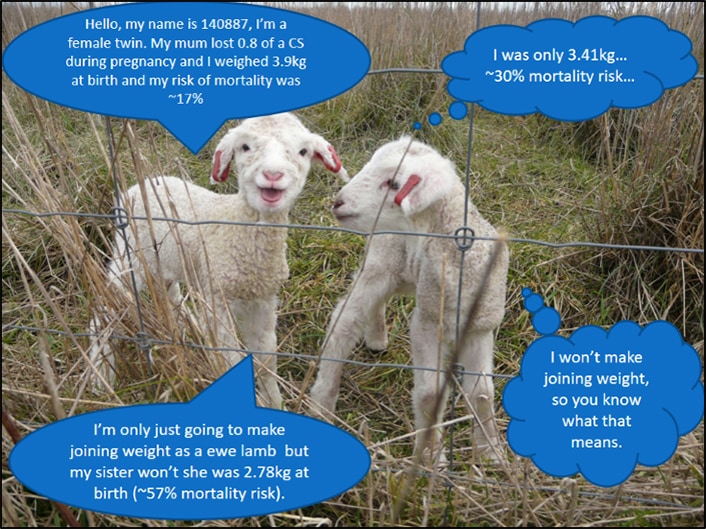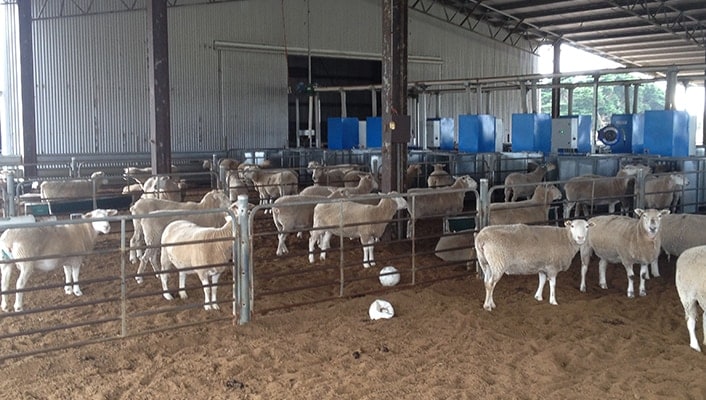Targets for maternals
Lifetime Ewe Management (LTEM) has been successful in promoting the requirements of merino ewes and the implications of not meeting these targets. Producers who have adopted LTEM practices have increased stocking rates and lamb marking percentages, and decreased ewe mortality.
Although some of these changes have also occurred on farms with crossbred and maternal composite ewes, guidelines developed for merino ewes with a focus on wool production are unlikely to be optimal for prime lamb production and maternal composite ewes.
This article outlines the results from a series of experiments that aimed to test and develop guidelines for crossbred ewes used for prime lamb production, such as first cross and maternal composite ewes.
Condition score and feed requirements of maternal composites
Field experiments on four sites across southern Australia using 6000 pregnant ewes were conducted in 2014 and 2015.
These experiments investigated the impact of different condition scores (CS) during mid- to late pregnancy on maternal composite ewes, and the impact of different levels of feed on offer (FOO) at lambing and during lactation.
The results showed there were predictable impacts of manipulating ewe liveweight or CS during pregnancy on the birthweight of single and twin lambs.
Low ewe CS at lambing had a negative effect on birthweight and lamb growth rate to weaning, resulting in lower carcase weight at slaughter. The mating weight of ewe lambs and carryover reproduction of the ewe were also affected.
Lower ewe CS (2.5–2.7) at lambing had little effect on survival of singles, but CS greater than 3.5 had negative effects due to dystocia. Improving CS at lambing increased twin lamb survival at all research sites, which was near maximum when ewe flocks achieved an average CS of 3.2–3.5 at lambing.
Having high levels of FOO at lambing and during lactation did not completely offset the impacts of poorer nutrition during pregnancy on birthweight and weaning weight.
Our field experiments also showed that the maternal composite ewes were gaining weight during pregnancy at lower FOO levels than expected. These results raised questions about whether maternal composite ewes were more feed-efficient or just eating more.

Bigger eaters or more efficient?
Animal house experiments were conducted to investigate the maintenance energy requirements and energy efficiency of maternal composite sheep. The feed intake of crossbred ewes grazing at different levels of FOO was also investigated.
These experiments showed that these ewes had higher feed intake than expected at different levels of FOO under grazing, compared with the current feeding standards for sheep. The ewes also had higher potential feed intake than predicted, based on their size and CS.
The energy contained in the tissues of their liveweight gain also varied from the estimates used in the current standards to calculate nutritional requirements. This was most likely due to differences in body composition (fat and muscle).
New CS targets for maternal composites
The results of these studies were used to update the feed budgeting models and the production responses within a whole-farm model to predict the optimum CS targets for different regions.
Optimum CS targets for a typical farm in the Hamilton region were determined for a prime lamb producing enterprise that purchased all replacement ewes. Three different times of lambing were evaluated for this farm using the model (Table 1).
Table 1 Optimum condition score (CS) at joining, day 90 and lambing for each lambing date, if the flock is scanned for multiples, on a typical farm at Hamilton
| Lambing date | CS at joining | CS at day 90 of pregnancy | CS at lambing | ||
|---|---|---|---|---|---|
| All ewes | Singles | Multiples | Singles | multiples | |
| 15 April | 3.8 | 3.6 | 3.7 | 3.1 | 3.7 |
| 1 June | 4.1 | 3.7 | 3.7 | 3.1 | 3.5 |
| 5 August | 3.9 | 3.3 | 3.3 | 3.0 | 3.4 |
Although these targets have been developed for Hamilton, they are unlikely to be very different for other areas, especially the targets at lambing.
The optimum target for CS at joining may vary slightly based on time of lambing and the cost-effectiveness of feeding ewes to reach targets. For earlier lambing, the optimum CS at joining at the end of spring is the level that the ewes reach without supplementary feeding.
However, the highest CS needs to be managed so that the target lambing CS can be achieved without excessive liveweight loss during early and late pregnancy. For later lambing, liveweight loss from the peak highest CS at the end of spring is managed with supplementary feeding to achieve the joining CS that allows the lambing target to be achieved without excessive liveweight loss.
The optimum target is to join ewes at CS 3.8–4.1 and to lose condition (up to 1 CS) during pregnancy, resulting in lambing at CS 3.0–3.1 for single-bearing ewes and CS 3.4–3.7 for multiple-bearing ewes (see Table 1 for CS targets at Hamilton).
The difference from the recommendations for merino ewes is that the optimum in high-rainfall environments for merino spring lambing ewes is to join and lamb at CS 3 (or CS 3.3 for twinning ewes ).
The higher CS at joining for maternal composites is driven by the higher CS at lambing and recovery of CS after lambing to reach higher CS at the end of the growing season, which also supports higher conception rates.
To achieve these targets, the challenge is to manage weight loss over summer, autumn and early winter when feed quality and quantity are usually limiting.
The difference in optimum guidelines for multiple- and single-bearing ewes reinforces the value of pregnancy scanning and managing ewes to their nutritional needs and targets. Single-bearing ewes need to lose 0.7–1 CS between joining and lambing to avoid dystocia, and can lose weight in both early and late pregnancy.
Multiple-bearing ewes can lose some weight in early pregnancy, but must then maintain weight or have only a small, slow weight loss in late pregnancy.
Key messages
- Maternal ewes eat more at lower FOO than indicated by current guidelines.
- Guidelines for managing crossbred and composite ewes are different from the target CS recommended for merino ewes.
- Optimal CS at lambing is similar to merinos for single-bearing ewes (CS 3) but higher for multiple-bearing ewes (CS 3.4–3.7).
- Single-bearing ewes need to be managed to ensure that they are not overweight at lambing, which increases the chance of dystocia.
- Pregnancy scanning of ewes will allow single- and twin-bearing ewes to be managed to optimise ewe and lamb survival, and consequent growth rates.
This research was supported by Meat & Livestock Australia, Agriculture Victoria, the South Australian Research and Development Institute, Rural Industries Skills Training and Murdoch University.
